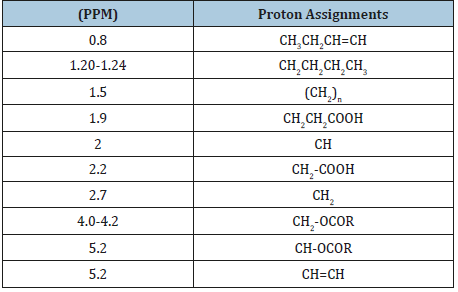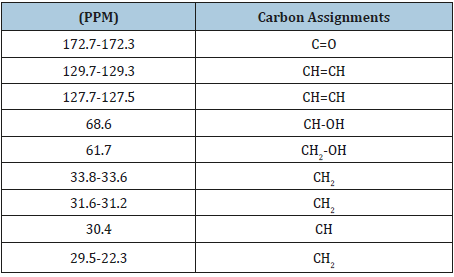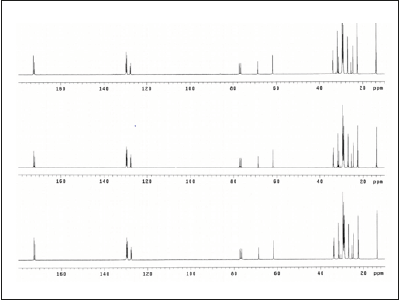- Submissions

Full Text
Evolutions in Mechanical Engineering
NMR Study of Cumbaru Oil to Apply as Mechanical Engineering Lubricant
Bathista ALBS*
Department of Education, Várzea Grande, Brazil
*Corresponding author:Anna A Betruger, Institute of Engineering, USA
Submission: June 24, 2019;Published: August 30, 2019

ISSN 2640-9690 Volume2 Issue5
Abstract
According to the great importance that seed oils has in relation to human health, cumbaru seed oil (DIPTERYX ALATA VOGEL) had its chemical structure and positional distribution of glycerol chains investigated by solution 1H and 13C NMR, as well as the natural degradation has been evaluated. The NMR techniques applied to the study of this oil showed that it is mainly constituted by oleic and linoleic glycerols with low content of saturated glycerols such as palmitic. Another important point was that this oil did not degraded or oxidated by itself or by light action quickly, it was stored at normal laboratory conditions during two years, and it was analyzed after that time and both 1H and 13C solution NMR spectra presented the same signals since this oil was extracted from the seed.
Keywords: Cumbaru oil; 13C NMR; Chemical characterization
Introduction
SSeeds are a great source of fiber, lignans, protein, fat, vitamins, minerals and oils. An extensive range of seed oil has high quality for nutritional uses, focusing on bulk nutritional oils. Seeds are also one of the best sources for the essential fatty acid alpha linolenic acid. Alpha linolenic acid is so important for bodybuilders because it “enhances insulin sensitivity within muscle cells.” This omega-3 fatty acid also has many other beneficial effects. Fruit seed from which oil is extracted, such as cumbaru have high oil content (30-40%). When the whole seeds are eaten, it is suspected that the oil portion is very slowly released and metabolized, preserving and enhancing both stable energy levels and favorable blood fat chemistry. The oils in oily seeds are an excellent energy source and the seed oil is also a rich source of linolenic acid [1-3].
Seed oils derived from tropical fruit can have a high commercial value, because of diversity uses such as pharmacological, cosmetics and food industries, which depends of its chemical composition. The content of linoleic and/or linolenic acids may promote aggregate values to those oils. According to the composition of seed oils they can be used in a wide variety of applications, from analgesic to digestive. The cumbaru fruit comes from Fabaceae family, its seed presents a high nutritional value with ~26% of proteins and can be eating crude or tosted [4,5]. The chemical components and properties of this fruit have a great importance in Brazil, especially in Mato Grosso State. Because of this different researcher have been developed and several studies to improve its production and application are in progress. The nutritional properties of the virgin oil have a good quality and it is frequently used for the people as tobacco aromatizing and also as anti-rheumatic [6]. According to those people speculations, the objective of this work is to study the chemical composition of cumbaru seed oil. For that reason, we have chosen nuclear magnetic resonance (NMR) employing 1H and 13C nuclei, as they are one of the best probes to generate response on this type of information [5- 11]. Another purpose for choose NMR is based on the fact that no previous sample treatment like separation, esterification and other need to be done.
Experimental
NMR Spectroscopy
Cumbaru seed oil was extracted with acetone; this oil is yellow and has a sweet smell. The analyzes of 13C NMR solution were recorded on VARIAN MERCURY 300 spectrometer, operating at 300MHz for 1H and 75.4MHz for 13C. The samples concentration for 13C analyses was about 20% of oil in 3.5ml of chloroform-d using a 10mm NMR tube at temperature of 26C, in the broadband proton decoupling mode. The quantitative 13C NMR spectrum was acquired using 16K data point, spectral width 220ppm, acquisition time 1.8s, relaxation delay 6s, pulse width 90, no NOE effect and 25000 scans. Highresolution carbonyl spectrum was recorded with a 32K data point, spectral width 10ppm, acquisition time 21s, relaxation delay 5s and a 90 pulse [3]. For the 1H NMR spectrum the sample concentration was about 2% of oil in 0.7ml of CDCl3 using a 5mm NMR tube at 26C. The 1H NMR spectrum was acquired using 16K data point, spectral width 12ppm, acquisition time 3.3s, relaxation delay 1s, pulse width 45 and 256 scans.
Result and Discussion
The assignments of partial 1H spectrum of the cumbaru seed oil acquired after solvent extraction of the cumbaru fruit seed are listed in Table 1. From the assignments it can be seen that the oil is manly constituted by triacylglycerols, with long aliphatic chains (Table 1). The same NMR study was carried out after it has been stored for six months, one year and two years. The results of both hydrogen and 13C assignments were the same as it was done immediately the oil has been extracted from the seed. No difference on chemical shift assignments for the proton spectra after two years stored at room temperature was found, indicating that the sample did not change by itself along this time. The 1H NMR spectrum of the cumbaru oil showed oxidation stability and don’t have demonstrated the presence of minor components (Figure 1) (Table 2).
Figure 1:1H NMR spectrum of the cumbaru oil after two years of being extracted.

Table 1:Chemical shifts and hydrogen assignments of cumbaru oil, after solvent extraction.

Table 2:Chemical shifts and hydrogen assignments cumbaru oil, after two years stored.

Table 3:Chemical shifts and 13C assignments, for the cumbaru oil after solvent extraction

In the Figure 2 a signal located at 30.6ppm was investigated by a technique named attached proton test (APT), which separates the different types of carbons. The methyl (CH3) and CH were detected inverted and methylene carbons and no protonated carbons were normally detected. The signal at 30.0ppm was assigned as CH, which is a carbon that probably presents a branch (Figure 3). This signal was also observed in the Figure 2 showing that the oil did not show any evidence of degradation or un-stability due to oxidation process. From the 13C high-resolution carbonyl spectrum the positional distribution of the glycerols along the chains was determined. The relation of the integration area of the carbonyls located at 172.8ppm represents the substitution in sn-1,3 position and the carbonyls located at 172.4ppm shows the substitution in sn-2 position.
Figure 2:13C NMR spectrum of cumbaru seed oil after it has been extracted from the seed.

Figure 3:Comparison of 13C NMR spectrum of the cumbaru oil:

1. After six month
2. Two years and
3. Immediately extracted.
Conclusion
According to the main purpose of this work, the NMR techniques were applied to the oil and the data obtained showed the main chemical compounds and the positional distribution on triacylglycerol chains. The most important conclusion was that this oil did not degraded by itself or by lights during the time studied, which is very good, for example, food and lubricant applications.
Acknowledgment
The author would like to thank you CNPq, CAPES and IFMT.
References
- Moreto E, Fett R (1989) Óleos e gorduras vegetais, Florianópolis, UFSC, Brazil.
- Gunstone FD (1993) Advances in Lipid Methodology. In: Christie WW (Ed.), Oily Press, Dundee, Scotland, UK, p.1.
- Sacchi R, Patumi A, Fontanazza G, Barone P, Fiodiponti P, et al. (1996) A high field 1H nuclear magnetic resonance study of the minor components in virgin olive oils. J Am Oil Chem Soc 73(6): 747-758.
- Bellinelo LC (1996) Biologia Vegetal. Coleção Objetivo, São Paulo, Brazil, V. 4.
- Ferreira RA, Soraya AB, Antonio CD, Marlene MM (1998) Morphological characterization of fruit, seed, seedling and mud DE dipteryx alata vogel-baru (leguminosae papilionoideae). Cerne 4(1): 073-087.
- Sacchi R (2000) Applications of Magnetic Resonance in Food Science. Annals of the fifth international conference, Aveiro, Portugal, p. 120.
- Sacchi R, Addeo F, Guidicianoi I, Paolillo L (1992) Ital J Food Sci 4: 117.
- Wollenberg KF (1990) Quantitative high resolution 13C nuclear magnetic resonance of the olefinic and carbonyl carbons of edible vegetable oils. J Am Oil Chem Soc 67(8): 487-494.
- Sacchi R, Addeo F, Paolillo L (1997) 1H and 13C NMR of virgin olive oil. An overview. Magnetic Resonance in Chemistry 35(13): S133-S145.
- Silva EO, Bathista ALBS, Tavares MIB, Filho NP, Nogueira JS (2005) 13C NMR study of peach oil. Journal of Food and Agriculture 85(13): 2269-2272.
- Nascimento AM, Tavares MIB (2007) Solid state NMR study of couma utilis Int J of Polym Mat 56(4): 115-125.
© 2019 Bathista ALBS. This is an open access article distributed under the terms of the Creative Commons Attribution License , which permits unrestricted use, distribution, and build upon your work non-commercially.
 a Creative Commons Attribution 4.0 International License. Based on a work at www.crimsonpublishers.com.
Best viewed in
a Creative Commons Attribution 4.0 International License. Based on a work at www.crimsonpublishers.com.
Best viewed in 







.jpg)






























 Editorial Board Registrations
Editorial Board Registrations Submit your Article
Submit your Article Refer a Friend
Refer a Friend Advertise With Us
Advertise With Us
.jpg)






.jpg)














.bmp)
.jpg)
.png)
.jpg)










.jpg)






.png)

.png)



.png)






